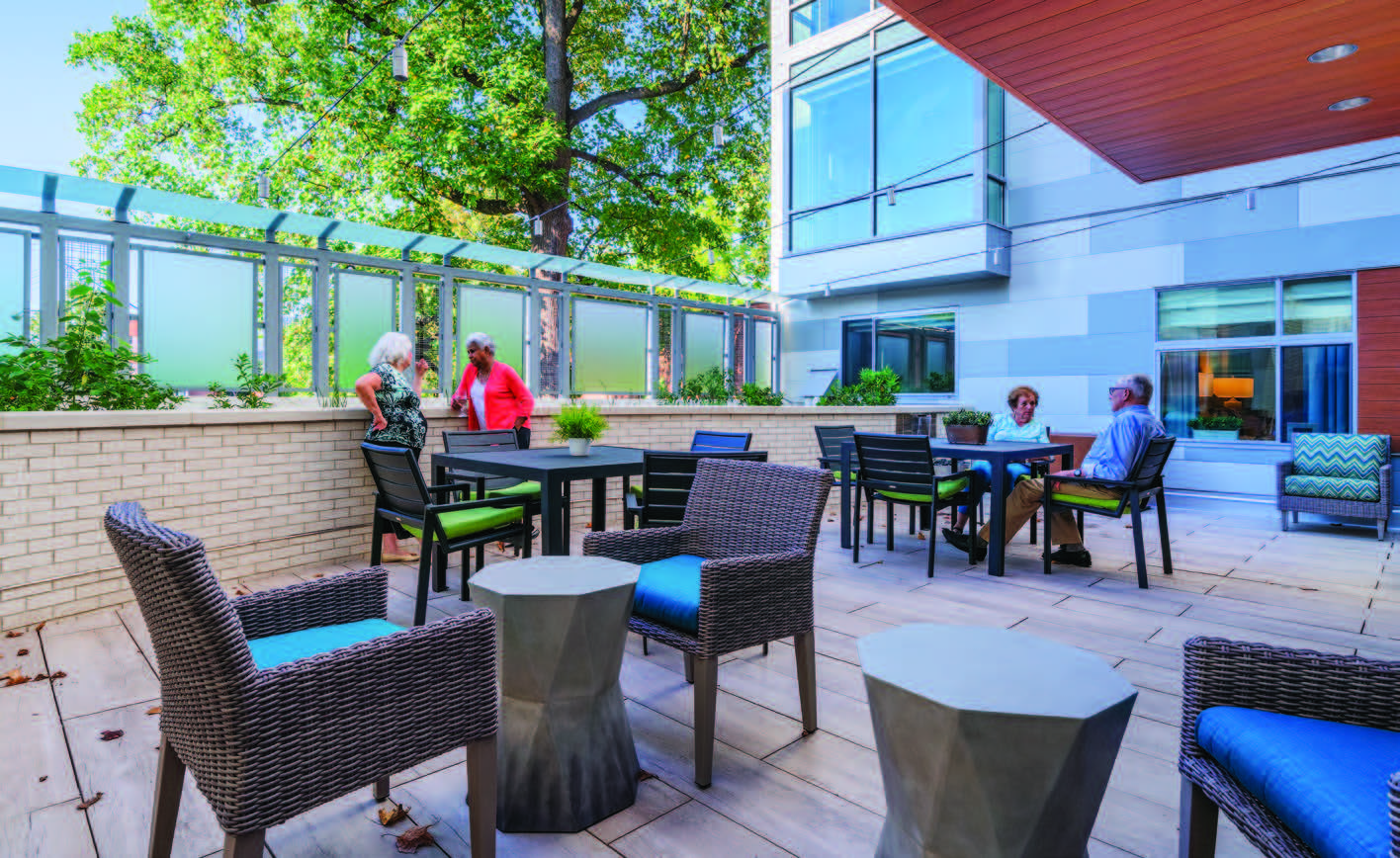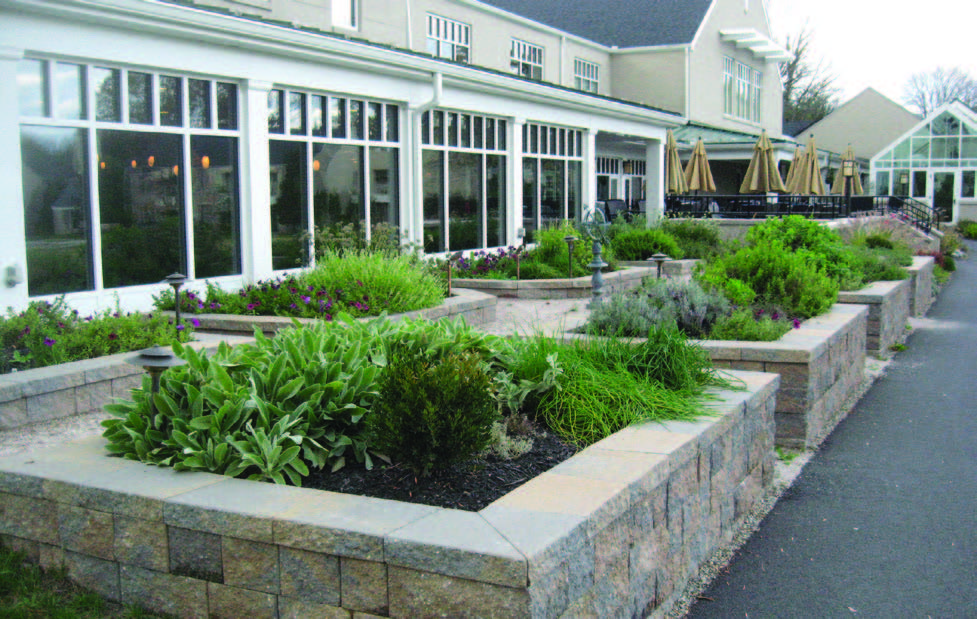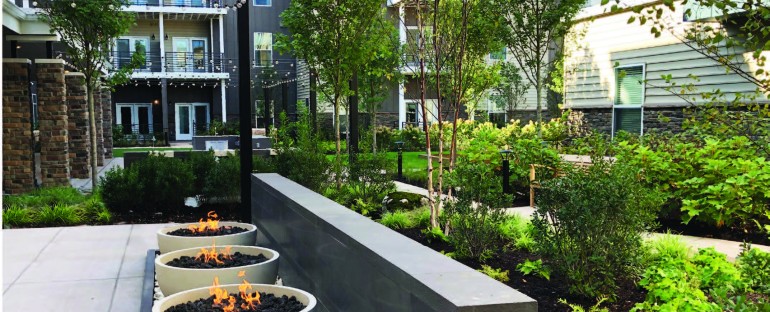- Home
- About Jack Carman
- Case Studies
- Brandermill Woods Alzheimer’s Garden
- Cathedral Village Butterfly Garden
- Foulkeways CCRC Herb Garden
- The Gift of Life Family House
- The Tranquility Garden at McAuley Convent
- The Healing Garden at Kimball Medical Center
- Meadowood Senior Living, Worcester, PA
- The Woodland Garden at Meadowood
- The Atrium Garden at Meadow Lakes
- The Back Porch Garden at Medford Leas
- Therapy Garden at Merwick
- River Garden at the Atrium
- St. Francis Country House
- St. John Neumann Nursing Home
- St. Mary Manor Nursing Home
- Virtua Camden Hospital
- Services
- News
- FAQs
- Useful Links
- Contact Us
SENIOR LIVING EXECUTIVE – JANUARY/FEBRUARY 2020
By Cynthia Bombach
Just like many other community operations, landscaping today has to do more with the same resources. While it’s important to offer curb appeal that makes every resident and visitor feel at home and welcomed, landscaping needs to work within a community’s budget—that’s both for establishment and maintenance, today and for the long term. On top of that are new expectations for sustainability, whether these are motivated by regulation or mission—and usually, it’s both.
Fortunately, communities don’t always have to choose between helping the environment and helping themselves. In fact, with the right design, choices, and techniques, landscapes can even be managed to create a net benefit, without stinting on quality.
Location, location
The first key: Find experts who know your location and what plants grow naturally there. Landscape architect Julie Higgins is principal in the landscape studio at Hord Coplan Macht, a Baltimore-based architecture firm with a specialty in senior living. She works with an eye toward sustainability for both the environment and the community.
“We focus on using native plants, because they are better adapted to the environment and have lower maintenance,” she said. A landscape plan that uses a limited selection of plant material can save money and still be attractive by relying on bold colors, varying textures and seasonal interest.
Second is healthy soil—often an overlooked piece of the landscape puzzle. Higgins cautions against scrimping on this crucial component, as that can lead to problems later.
“You wouldn’t cut the budget on your building foundation and use cheap concrete,” she says. “You also have to have a good foundation for the plant material.”
Organic practices such as adding compost at planting time, mulching and using integrated pest management will keep the soil in good shape.
“If you take care of your soil conditions, your plants do better and require less maintenance,” Higgins says.
Another important factor: Knowledgeable landscape staff. A well-maintained landscape is more economical to operate than one that is allowed to develop problems. Maintenance staff should be proactive in monitoring plant health, soil conditions, and irrigation systems.
Choosing the right trees and shrubs can also improve operating expenses. Deciduous trees—those that lose their leaves in autumn—offer year-round benefits. They can shade buildings in summer to reduce cooling costs, while in the winter they allow more sun to shine through. Choosing shrub varieties that grow slowly and don’t branch out beyond their allotted space means less work for landscape maintenance staff.
The classic green lawn and formal, precisely trimmed hedges eat up expenses: Water, maintenance, fertilizers, and even solid waste disposal costs all go up. Having smaller areas of lawn in your landscape design can cut these back.

Security and greenery at Brightview Woodmont’s memory care terrace, designed by Hord Coplan Macht
Water is the new gold
Water is an increasingly precious–and expensive–resource in the landscape, no matter what location. Its use and conservation are important factors when planning sustainable landscaping for senior living communities.
For ideas on saving water, look to places with years of experience. In Tucson, Ariz., for instance, water conservation is mandated by local ordinances; using native plants is a necessity. For instance, at Watermark at Continental Ranch, which opened in Tucson in May 2019, plantings are entirely desert natives, such as sage and cacti. Each week, a landscape maintenance company pulls weeds, checks plants, and adjusts the irrigation system.
“Water is a precious resource in the desert and it’s our responsibility to preserve it,” says executive director Gary Hughes. “Using plants that are indigenous to the area and maintaining the high-efficiency watering system installed throughout the community helps ensure costs are kept to a minimum.”
Too much water can also increase expenses through erosion—and uncontrolled runoff, particularly during construction projects, can even land you a fine. But rainwater management can help save money.
Willamette View, a nonprofit CCRC outside of Portland, Ore., uses green roofs to manage runoff into the adjacent Willamette River. In 2019, it transformed a large asphalt parking lot into a series of carports, for multiple benefits.
The roofs are topped with sedum plants in two-by-four-foot plastic trays. The growing medium absorbs and filters rainwater, letting the rest drain through the trays into the campus drainage system.
The green roofs have the side benefit of creating a better view for residents whose apartments overlook the roofs. Parking areas are protected and shady. The green roofs also help to attract new residents, many of whom have a strong interest in sustainability and environmental conservation.
“This is part of our social responsibility, managing runoff from our property,” says CEO Craig van Valkenburg.
Green roofs are becoming a popular option in urban areas for rainwater management, easing heat, and human well-being.
If done properly, green roofs can garner LEED points and earn grants, rebates, or tax credits in some regions. The downside: A green roof is more expensive to install than a regular roof, and it requires more maintenance. But each community is unique and has its own way to measure the pros and cons of a green-roof investment.
Landscaping for resiliency
One of the hottest topics in land management today is the concept of resiliency.
A resilient landscape is one that can adapt to changes in its environment and regenerate itself when necessary. Those changes may be gradual and long-term, such as a shift toward warmer temperatures, or more sudden and short-lived, as in the case of seasonal droughts.
Consider the cost of plant replacement and outdoor infrastructure restoration after an extreme weather event, and the operations advantages of a resilient landscape become clear.
“A resilient landscape is one that can be maintained within extremes of heat, storms, flooding and some of the more extreme climates that we have now,” Higgins says.
“You hear a lot about that especially near waterfront properties. Water levels are rising, so your design should anticipate those changes.”
A landscape near the shore is more resilient when it contains a variety of coastal plants and can withstand high winds, salt and floods, for instance.
Resiliency and sustainability go hand-in-hand. Both rely on the use of native plant material and are most successful when they maintain natural biodiversity. True resilience depends upon creating a complex ecosystem—and this may be difficult to achieve in practice. Implementing sustainable principles and preserving native plants and landforms are manageable steps that communities can take toward landscape resilience.
Old faves, new trends
Some aspects of senior living landscaping will never go out of style. Walking paths, shaded seating areas, and water features will always be in demand. In recent years, fire pits and resident gardening plots have become ubiquitous. Some communities foster a strong collaboration between residents and culinary staff to grow produce featured in the dining program.
Also trending is installation of outdoor fitness equipment such as that found in many public parks. Devices geared toward the needs of older adults are easy-to-use ways to help maintain strength, mobility, and balance.
In urban areas, rooftop gardens—as opposed to green roofs, in which plants cover the entire roof—are growing in popularity. Vertical container gardens give residents a place to grow plants without using a lot of space. Water features on a rooftop can help mask the sounds of the city.
Blurring the boundaries between indoors and out is another trend. “Green walls” are densely planted vertical spaces, often with contrasting plants that create attractive patterns.
And Jack Carman, founder and president of Design for Generations in Medford, N.J., suggests enhancing such indoor garden spaces with the sounds of waterfalls and chirping birds. Placing plants throughout the buildings will help residents maintain a healthy connection to nature. “People feel good about having plants growing in the environment they’re living in,” Carman said.
LANDSCAPES DESIGNED FOR WELLNESS
Interaction with nature is innately beneficial to human well-being. Studies have shown that being outdoors in a natural setting can help older adults feel more energetic, have less depression, improve their cognition and feel more engaged in life.
Exposure to sunlight permits natural absorption of vitamin D and helps to balance circadian rhythms. One study of memory care residents in California showed that early morning exposure to sunlight improved their moods and reduced discomfort.
Gardens specifically designed to promote wellness are an increasingly popular feature at many senior living communities, providing places for residents, staff, and visitors to find rest and renewal.
Willamette View’s “Harmony Garden,” installed in 2012, is a good example. In a courtyard next to the memory care neighborhood, it includes a variety of plants meant to stimulate the senses, such as aromatic herbs, fuzzy lamb’s ears, bright flowers, and apple trees. The garden is wheelchair and walker accessible and is visible from multiple indoor areas. A figure-eight walkway, water feature, and ample seating make it a popular site for community picnics as well as resident and staff relaxation.
Elements of a Wellness Garden

Sensory appeal of herb gardens at Foulkeways at Gwynedd, designed by Jack Carman, Design for Generations
Certain principles are standard for any garden tailored to older adults, especially those with dementia. The priority is safety. Plant material must be nontoxic and free of thorns. Walkways should be level and clearly defined.
For memory care residents, it’s important to create secure gardens. Walls and gates can be attractive, and their appearance softened with plantings.
Wellness gardens can also contain specific elements for occupational and physical therapy. For instance, raised planting beds allow accessibility so residents can touch and smell the plants.
The best plants for wellness gardens are those with pleasant aromas and contrasting or colorful foliage and flowers. Adding water features and elements that attract birds and butterflies will make the garden even more appealing.
“Make it feel like it could be your backyard,” says Jack Carman, founder and president of Design for Generations in Medford, N.J. Use familiar types of plants, provide shaded areas, and offer comfortable seating.
Even residents who don’t go outside can enjoy the garden from indoors. Low windows overlooking the garden will allow people to enjoy the view while seated.
Finally, include something for every season. “You want it to look fresh and inviting year-round,” says Eric Drenner, co-founder and partner of E-Landscape Specialty Solutions, in Davidsonville, Md. Adding sculptures, evergreens and bird feeders can make winters as fascinating as summers in the garden.
Originally published: https://content.yudu.com/web/406u7/0A40767/SLEJan.Feb2020/html/index.html?page=20&origin=reader
Recent Articles
- 15Oct
Healing Design: The Benefits in Creating Therapeutic Gardens
Imagine a place that can do the impossible – spark...
- 04Nov
Trees Are Therapeutic
Trees! We all know that they provide shade and give...
- 27Oct
Is The Covid-19 Pandemic Reviving A Historic Residential Design Feature?
The pandemic has changed our relationship with our...
- 28May
Time to Watch Clients’ Gardens Grow
After being cooped up indoors due to shelter-in-place...
- 27Feb
Landscaping Can Grow Engagement While It’s Shrinking Expenses
Just like many other community operations, landscaping...
Recent Case Studies
Categories
Contact Information
Popular Posts
-
HORTICULTURAL THERAPY AND VETERANS
Horticultural TherapyVarious programs are are being developed to help Veterans...
-
FOOD GLORIOUS FOOD
Horticultural TherapyVisiting London, I came across a demonstration community...
Categories
To find out more, including how to control cookies, see here: Cookie Policy














